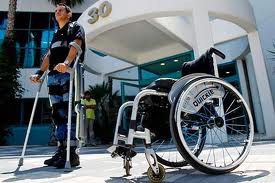From the 8th to the 13th of October 2013, the MEDTRADE Conference will be held in the Orange County Convention Center of Orlando, Florida. Designers, manufacturers and users of medical equipment will meet and take stock of technology and innovation in the field medical mobility and patient autonomy.
Being independent from the hospital
« By providing battery powered systems for many medical devices, we help people with a mobility issue getting more autonomous than they often ever were” Forsee Power Solutions’ CEO Christophe Gurtner says. “Greater mobility therefore enable physically disabled people to take a greater part in their community and improve their quality of life considerably” he explains. The firm designs batteries and power supply solutions for medical equipment manufacturers. Hence, Forsee Power Solutions’ product can be found in oxygen concentrators, respirators, electrical muscle stimulation devices, wheelchairs, or infusion pumps. Electricity storage stands for a major technological challenge for that French engineering firm. The kind of products it makes enables millions of patients to leave the hospital and come back home already.
The possibility of being treated and monitored from home has a positive impact on the patient’s morale. Being taken care of outside of the hospital and in a familiar environment frequently results in better physical condition and faster recovery for the patient. Not everybody can afford being healed in such optimal conditions. In a lot of cases however, bringing medical equipment home is financially more interesting than staying in the hospital for a long time. The price of a stay in the hospital is dissuasive for many patients since it changes from one establishment to another, and can vary on a 1 to 120 scale for the same treatment! Dr. Jonathan Blum, director of the Center for Medicare explains how difficult it is for patients to understand and accept it. “What drives some hospitals to have significantly higher charges than their geographic peers? I don’t think anyone here has come up with a good economic argument”. In this light, the market for mobile medical equipment is very likely to keep growing since home hospitalization’s cost is more predictable.
Mobility in the medical field
Most of the devices with medical application are now available in transportable version. Such an evolution of the technology was required since medicine is now frequently practiced outside of the hospital, on the site of a natural disaster, of an industrial accident, of a war and so forth. In the ambulance or in the medical tents on a battlefield, medical equipment is needed and it better be mobile, reliable and safe even in the absence of basic infrastructure. This is one of the reasons that make R&D so important in that field. Ed Murphy is DeVilbiss Healthcare’s CEO. He knows all too well the importance of safety and reliability for his business which produces breathing assistance systems. “We’ll spend 50% more on R&D this year than last year, and we’ll spend 50% more than that next year” he said in 2013. Innovation is one of the key to maintain life-saving devices’ conformity with drastic medical and sanitary norms.
Mobility in the patient’s life
From an individual perspective, continuity of care is the major concern. A patient might be treated at home, but he needs to be sure he will recover as safely as if he stayed in the hospital with the doctors. Hence in April 2013, Philips Respironics for instance launched Sleep Mapper, a “mobile and web-based application” that enables patients suffering from obstructive sleep apnea to monitor their daily progress with their sleep therapy. With Sleep Mapper, patients who use Philips Respironics’ System One respiratory positive airway pressure devices can make sure their state is under control and can stay home unworried.
Design matters in many regards. Besides, a breathing assistance system would be useless without a reliable energy storage and distribution system. In this regard, Forsee Power Solutions’ idea of reliability is shared by others actors in the medical device industry. “We’ve invented many of the new, portable oxygen systems called transfilling systems and portable oxygen concentrators that allow people to be much more mobile with a greater capability to move around and integrate again into their communities” A. Malachi Mixon says. “Our products enable people to continue to remain active in the mainstream and continue to keep up with the family” the CEO of Invacare explains. Given the pace of population ageing and the development of respiratory diseases, there is little chance that the promises of Invacare – which is already among the world leaders in designing and manufacturing oxygen concentrators – will lose their edge in the future.
Mobile medical devices are more and more sophisticated, intelligent and automatized. Hence, autonomy is the main concern for both designers and users. Mobility and autonomy are no longer a luxury nor a gadget today. They have turned out to be a necessity for the patient welfare, and even a public health duty.

